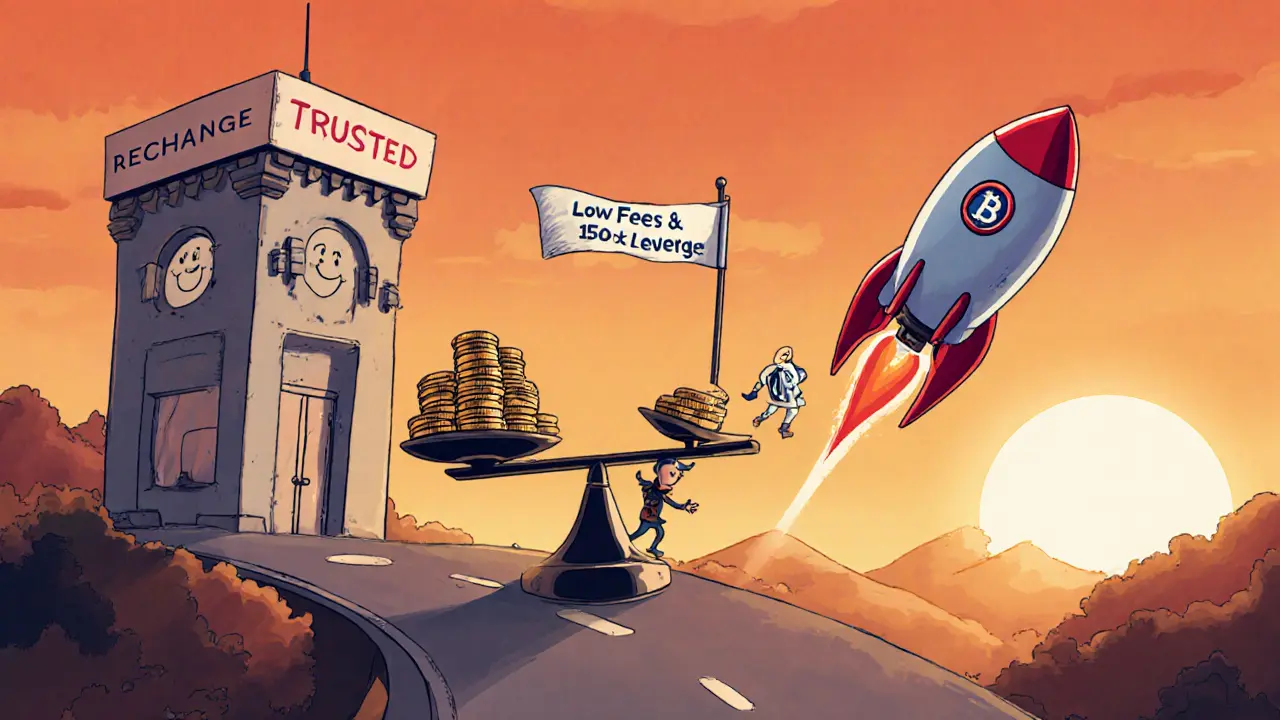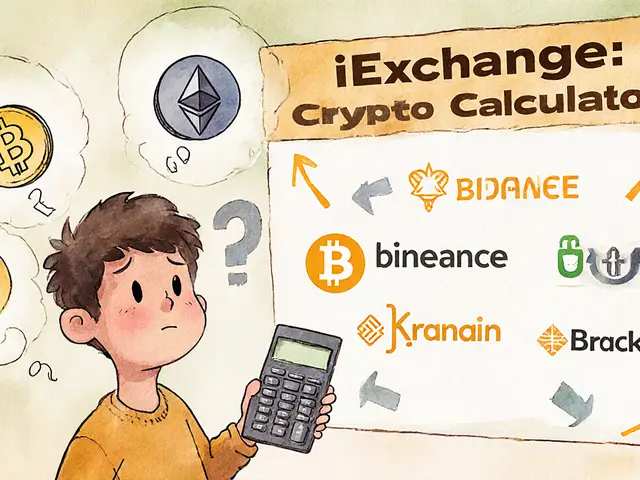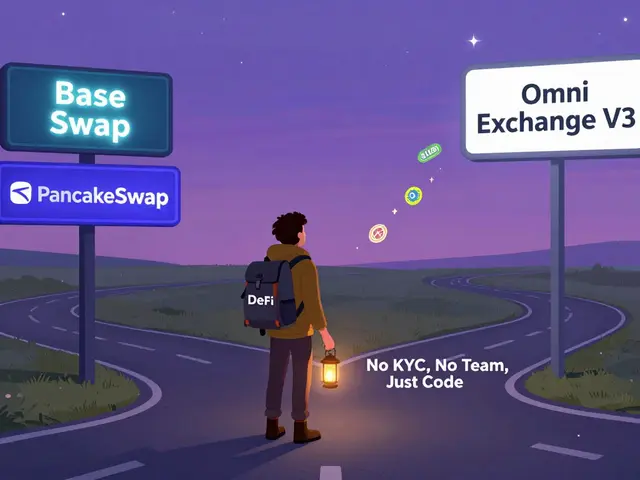Bibox Exchange Comparison Tool
Quick Comparison: Compare Bibox against top exchanges to evaluate features like asset coverage, leverage, fees, and trust scores.
Assets
500+
Leverage
1:150
Fees
0.01%
Trust Score
1.1/5
| Feature | Bibox | Binance | Coinbase | Kraken |
|---|---|---|---|---|
| Spot Assets | 500+ | 600+ | 200+ | 300+ |
| Max Leverage | 1:150 | 1:125 | 1:5 | 1:5 |
| Lowest Spot Fee | 0.01% (with BIX) | 0.02% (VIP) | 0.50% (standard) | 0.16% (maker) |
| Fiat Deposit | No | Yes | Yes | Yes |
| Trustpilot Rating | 1.1/5 | 4.5/5 | 4.2/5 | 4.3/5 |
| Regulatory License | None major | Multiple | US, EU, UK | US, EU |
Comparison Summary
Bibox Strengths:
- Huge selection of crypto assets (500+)
- High leverage options (up to 1:150)
- Very low fees for BIX holders (down to 0.01%)
Bibox Weaknesses:
- No direct fiat deposits or withdrawals
- Poor trust scores (1.1/5 on Trustpilot)
- Limited customer support (email only)
- No major regulatory licensing
Recommendation: Best for advanced traders who already hold BIX and don't mind the trust risks. Not recommended for new or casual users due to withdrawal delays and lack of fiat support.
Key Takeaways
- Bibox offers over 500 crypto assets and high‑leverage margin trading (up to1:150).
- Fees can drop to 0.01% for spot traders who hold the native BIX token.
- No direct fiat deposits are accepted - you must fund the account with crypto.
- Trust scores are low: 1.1/5 on Trustpilot and a 70/100 rating on ScamAdviser.
- Customer support is email‑only and many users report withdrawal delays.
Bibox review - If you’re hunting for a crypto exchange that promises AI‑enhanced trading and a massive asset list, Bibox might look tempting. Yet the platform’s trust deficits and fiat‑on‑ramp gaps make it a risky choice for most traders. Below is a deep dive into what Bibox actually delivers, how its fees work, and whether it lives up to the hype.
What Is Bibox?
Bibox is a cryptocurrency exchange launched in 2017 that markets itself as an AI‑enhanced, decentralized platform. The exchange claims to use artificial intelligence to improve order matching and market‑making, but most independent reviews treat the AI label as a marketing spin rather than a proven technical advantage.
Core Trading Services
Bibox packs a lot of features into a single dashboard. Here’s what you can do once you’re logged in:
- Spot trading for more than 500 cryptocurrencies (as of September2025).
- Futures contracts with fees as low as 0.04%.
- Margin trading with leverage up to 1:150.
- Perpetual contracts and options trading.
- NFT marketplace for buying and selling tokenized art.
- Passive investment products such as earn‑programs.
The platform integrates TradingView charts, so the visual tools feel familiar if you’ve used other exchanges.

Fee Structure Explained
Fees are one of Bibox’s strongest selling points, especially for high‑volume traders who hold its native BIX token.
- Spot trading: Base fee is 0.1% - 0.2%. Holding BIX and using it to pay fees can bring the rate down to 0.01%.
- Futures trading: Ranges from 0.04% to 0.06%, already lower than many competitors.
- Margin & leverage: Interest rates apply on borrowed funds; exact numbers vary by asset and leverage level.
- Withdrawal fees: Vary by blockchain; some networks charge a flat fee, others calculate based on network congestion.
The tier system is tied to BIX holdings, not KYC verification level. This means you can stay unverified and still enjoy the lowest fees if you own enough BIX.
Asset Coverage and Fiat Options
With 316 listed assets as of September2025, Bibox rivals the biggest exchanges on sheer variety. Popular coins like Bitcoin, Ethereum, and Solana are there, plus dozens of low‑cap altcoins.
On the fiat side, the exchange supports multiple fiat currencies for display (USD, JPY, etc.) but does not accept direct fiat deposits. You must first buy crypto on another platform, then transfer it to Bibox. Withdrawals to bank accounts are also unavailable, limiting convenience for newcomers.
Trust, Safety & Regulatory Standing
Trust scores are the main red flag for Bibox.
Trustpilot gives Bibox a 1.1‑out‑of‑5‑star rating based on over 170 reviews. Users repeatedly mention delayed or frozen withdrawals and unresponsive support.
ScamAdviser rates the site 70/100, placing it in a “moderate risk” bracket.
Traders Union scores Bibox 3.37/10, labeling it a higher‑than‑average risk exchange.
Regulatory oversight is almost non‑existent. Bibox does not hold licenses in the United States, European Union, or other major jurisdictions, which means user funds are not protected by any financial regulator.
User Experience - What You’ll Actually Feel
Signing up is simple: email, password, email verification. KYC can be completed in a few minutes by uploading a passport or driver’s license.
Where the experience falls apart is after you fund the account. Many users on Reddit and crypto forums report that withdrawal requests sit pending for days or even weeks. Support is limited to email, and ticket responses can take over a week.
The mobile apps for iOS and Android work well for charting and quick trades, but the same trust and support issues carry over from the web platform.

How Does Bibox Stack Up Against the Big Boys?
| Feature | Bibox | Binance | Coinbase | Kraken |
|---|---|---|---|---|
| Spot assets | 500+ | 600+ | 200+ | 300+ |
| Max leverage | 1:150 | 1:125 | 1:5 | 1:5 |
| Lowest spot fee | 0.01% (with BIX) | 0.02% (VIP tier) | 0.50% (standard) | 0.16% (maker) |
| Fiat deposit | No direct fiat | Yes (multiple currencies) | Yes (USD, EUR) | Yes (USD, EUR, GBP) |
| Trustpilot rating | 1.1/5 | 4.5/5 | 4.2/5 | 4.3/5 |
| Regulatory license | None major | Multiple (US, EU, etc.) | US, EU, UK | US, EU |
Pros & Cons at a Glance
- Pros:
- Huge selection of crypto assets.
- High leverage options for experienced traders.
- Very low fees for BIX‑holding users.
- TradingView chart integration.
- Cons:
- No direct fiat on‑ramps or withdrawals.
- Poor trust scores and numerous withdrawal complaints.
- Customer support limited to email with slow response.
- Lack of clear regulatory licensing.
Should You Use Bibox?
If you are a hardcore trader who needs high leverage, loves experimenting with obscure altcoins, and already holds BIX to shave fees, Bibox can be a useful niche tool. However, for most retail investors, the risks outweigh the benefits. The inability to deposit fiat directly means you’ll have to juggle another exchange just to move money in and out, and the low trust scores suggest you might face withdrawal headaches.
My practical advice: start with a well‑regulated exchange (Binance, Coinbase, Kraken) for the bulk of your trading. If you decide to dip a toe into Bibox, allocate only a small fraction of your capital-enough to test the platform’s speed and fee discounts, but not enough to cause anxiety if a withdrawal stalls.
Frequently Asked Questions
Is Bibox a decentralized exchange?
Bibox calls itself a decentralized exchange, but in practice it operates a centralized order‑book and custodial wallets. Users do not retain private keys when trading on the web platform.
Can I deposit USD directly into Bibox?
No. Bibox only accepts crypto deposits. To fund the account you must first buy crypto on another exchange or service and then transfer it to your Bibox wallet.
How do I get the lowest trading fees?
Hold the native BIX token and select it as the fee‑payment method. The more BIX you hold, the larger the discount-down to 0.01% on spot trades.
Is Bibox safe for large withdrawals?
Safety is questionable. Many users report delayed withdrawals, and the exchange lacks strong regulatory protection. If you need to move large sums, consider using a better‑rated exchange.
What support channels does Bibox offer?
Support is limited to email tickets. There is no live chat or phone line, and response times can be several days.









Manish Gupta
October 10, 2025 AT 03:25olufunmi ajibade
October 10, 2025 AT 10:19Abby Gonzales Hoffman
October 11, 2025 AT 00:42Cyndy Mcquiston
October 11, 2025 AT 04:58Natasha Nelson
October 11, 2025 AT 09:35Rampraveen Rani
October 12, 2025 AT 08:07ashish ramani
October 12, 2025 AT 16:31Sarah Hannay
October 13, 2025 AT 05:50Gabrielle Loeser
October 13, 2025 AT 19:04